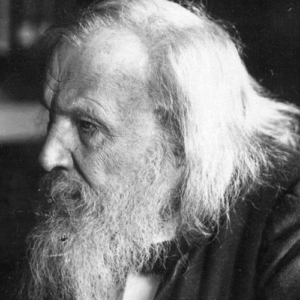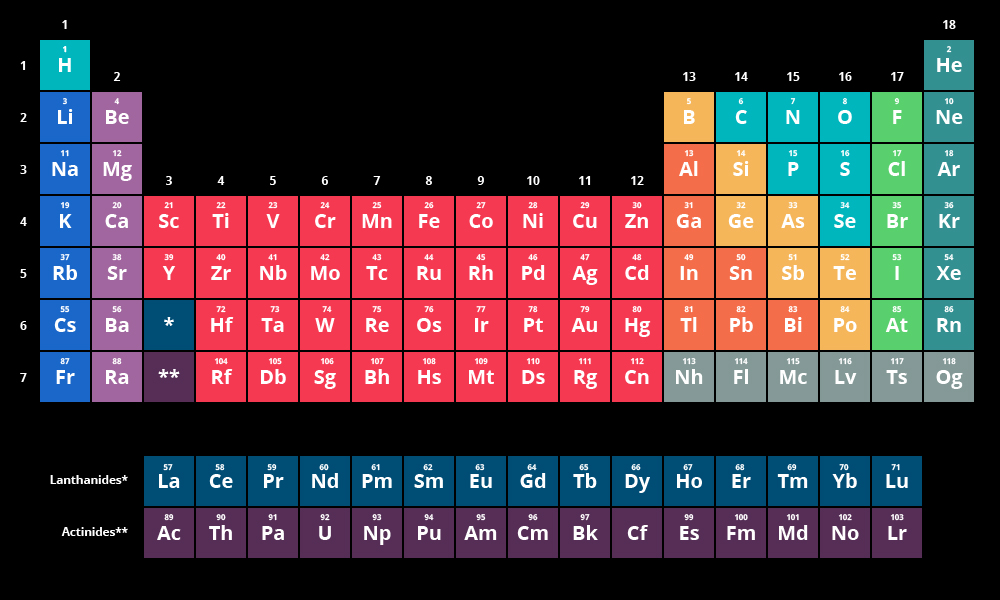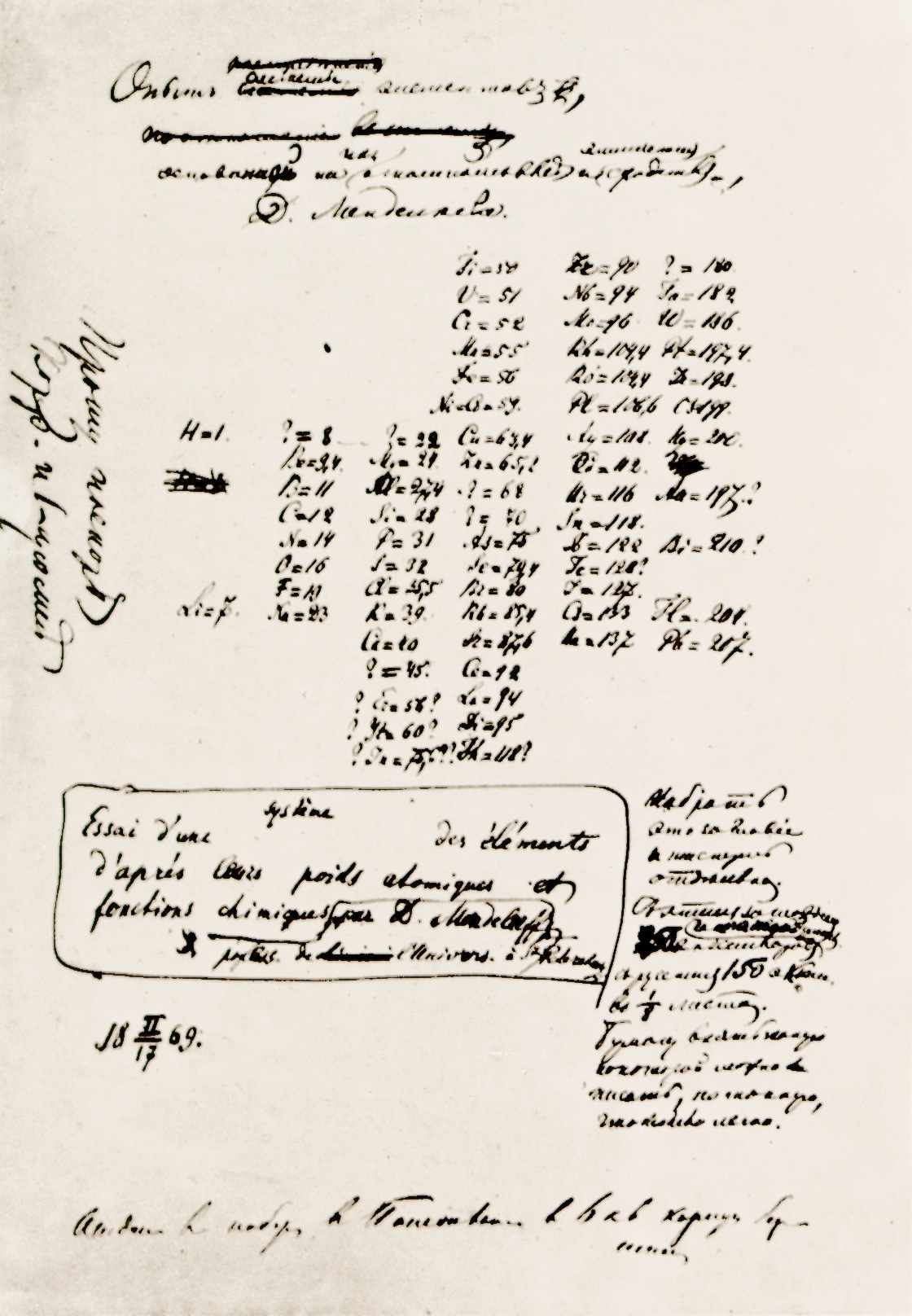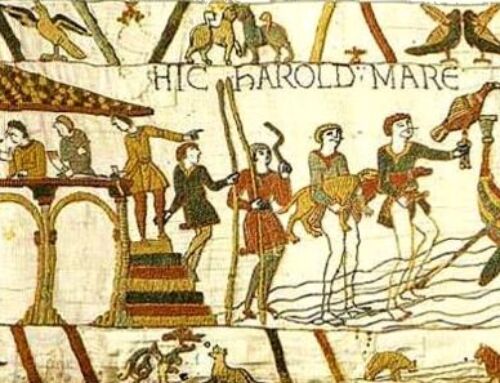Dreams are not always strange, disconnected experiences. Sometimes they are unified to the point of producing extraordinary blessings. In fact, one of the wonders of modern science came through a dream.
It’s called the Periodic Table of Elements, the fascinating chart that explains the way the microscopic building blocks of our physical world all fit together. Most of us probably studied the chart in high school – or at least saw a poster of it hanging on the wall of science class!
I call it a “wonder” because, when you hear about how it came into being, you will probably agree that its very existence is truly wonder-ful.
The Dreamer
 Russian scientist, Dmitri Mendeleev (pron. Men-dél-e-yev, 1834-1907), lived his whole adult life with the singular goal of bringing czarist Russia out of the technological Stone Age and into the modern world.
Russian scientist, Dmitri Mendeleev (pron. Men-dél-e-yev, 1834-1907), lived his whole adult life with the singular goal of bringing czarist Russia out of the technological Stone Age and into the modern world.
He made amazing strides in that effort through his contributions to chemistry. In fact, he was something of a Renaissance man in that field: professor, founder, pioneer, government official. He was also a popularizer of science who wrote more than 400 books and scientific articles during his career.
At the time of his dream, on February 17, 1869, there were 63 known chemical elements that Mendeleev had tried to categorize in some logical sequence but had failed (science had not yet discovered all of the 118 elements known to us today). He was one of many scientists during the same era who had tried to make sense of them without success.
At the risk of oversimplifying a complex matter, Mendeleev and others listed the elements by their atomic numbers and found out that a mere chronological list did not explain enough about their interaction with one another.
The list seemed jumbled and disordered. Elements that were liquid in their natural states were mixed in with solid elements with no obvious logic. The gases punctuated the list of solids and liquids in no apparent order.
Something was missing. Some organizing principle seemed just out of reach.
The Dream
One afternoon in his lab, Mendeleev wrote all the elements on 63 separate index cards and was playing a kind of solitaire with them, shifting them around to see what order would work best. Soon he grew mentally tired of the task, laid his head on the desk, and fell asleep with atomic numbers and symbols swimming around in his brain.
When he awoke, something had changed. It was all perfectly clear to him. He finally understood that the elements were more efficiently organized by their properties rather than by their atomic numbers! The organizational structure of it all was revealed to him while he slept.
“I saw in a dream, a table where all the elements fell into places as required,” he wrote later in a letter. “Immediately on awakening, I wrote it down on a piece of paper. Only in one place did a correction later seem necessary.”
When he classified the elements by their physical characteristics (properties) everything “fell into place”. Some of those properties are the following:
- atomic weight (different from atomic number),
- electronic structure,
- melting and boiling points,
- electrical and thermal conductivity,
- pattern of light absorption,
- radioactivity, etc.
All can be used for identification because they are unique for each element.
At the same time, he noticed that the elements fell into certain patterns, which repeated themselves in orderly sequences, according to their atomic weight. These repetitions he called periods, and thus was born the “periodic table” of the elements.
The first period contained two elements of similar characteristics (Hydrogen and Helium, top row). The following periods increased in number according to their greater complexity: 8 elements (rows 2-3), 18 elements (rows 4-5), and 32 elements (rows 6-7). Every period manifested elements with similar properties which were different from those of the other periods.
In fact, Mendeleev’s table was so accurate that he was able to predict where future elements, yet undiscovered, would take their place on the chart. If you look carefully at his handwritten chart, you will see three places that have question marks next to the numbers (see 68, 70, and 180 among others).
Only a few years later these new elements were “discovered” (gallium in 1875, scandium in 1879, and germanium in 1886), and they fit exactly into Mendeleev’s chart.
Everything just “fell into place”. How did that happen?
Angelic Intervention?
Did Mendeleev receive this wisdom from a bright angel who had been given charge by God over the elements of the world? Perhaps.
Skeptics will scoff at such an idea, but don’t discount the angelic answer too quickly. Think of how many times in the Bible some crucial information was communicated by an angel to someone in a dream or mystical state:
- Jacob wrestled with an angel and received a name change, which became the identity of God’s people: Israel (Gen 32:29);
- The Old Testament Joseph was so spiritually inclined that he correctly interpreted dreams that saved many thousands of lives (Gen 41:54);
- The New Testament Joseph saved the life of the Christ Child through a message received in a dream (Mt 2:13) – kind of a significant dream, if you ask me.
There are many more we could add here, but the point is that the information or instructions communicated by angels in these dreams could not have been obtained through a natural process. So, here we face a crucial distinction:
- Angels communicate messages from God that no human being could possibly know or discover by human effort alone;
- The human mind, on the other hand, absorbs and stores information that has been collected by the senses, and then it “processes” that information for greater insight about the natural world.
Likely Explanation
In short, Mendeleev’s dream probably has a perfectly natural explanation. The man who spent his waking hours thinking about the natural world collected and held all his scattered scientific information in his rational mind and struggled to understand it. One afternoon, as he dozed, that mind connected the dots and produced a coherent explanation for a complex reality.
He was given a sort of instant snapshot of his field that explained material reality in a new way. It may have seemed like a dream, but it was really the natural functioning of the human mind. We call this mysterious organizing power of the mind intuition.
Intuition is not a rational power like analysis. It usually works best when the rational power is shut off for a while. It is a function of the mind that organizes sense data, disparate bits of knowledge, images, symbols, experiences, even random emotions, and then creates insights (and fantastic charts) out of those raw materials.
Reason divides, intuition unites. Maybe that’s why the Periodic Table almost had to be revealed in this way. The elements were already separate pieces of knowledge laying around like a bunch of Scrabble pieces needing the proper board. They needed the right unifying power.
Have you ever noticed that people who take vacations or retreats usually come back filled with bright new ideas? There’s a reason for that. By turning off the analytical mind for a while, the intuitive mind can do its work.
It’s also not surprising that people who are good at puzzles are usually intuitive. Puzzle-work is the act of fitting pieces together, filling in gaps, and forming a picture with disconnected shapes, colors, and symbols. The intuitive mind is a puzzle solver.
In fact, the Periodic Table looks sort of like a puzzle, doesn’t it?
Interlocking Gifts
I certainly couldn’t recite the elements of the Periodic Table if you paid me, but Mendeleev had them all in his head, very literally. He dwelt deeply on chemistry his whole life, and after many years of rational engagement with this subject, the intuitive fruit of all that study took graphic form in the colorful little boxes of the Periodic Table. He used his natural gift well.
In doing so, he revealed to the world another marvelous gift, what Einstein later called the sheer “intelligibility” of the cosmos.
Our natural world is not chaotic. It is ordered, richly complex, and understandable. The orderliness of God’s creation is reflected not only in the elements of the earth but also at the macro level of the universe and in the micro details of quantum physics.
Einstein and Mendeleev were right. The world is intelligible, and its secrets can be revealed to us through analysis, exploration, and intuition.
Above all, the Periodic Table shows that some indescribably powerful Mind that has put the universe together, and its very complexity is a sacred window of wonder.

Soul Work
The two conditions of a healthy intuitive mind are thus: 1) a focused mental engagement in some subject, and 2) a rested body and soul.
Today, resolve to cut down on distractions and dissipating activities. Ask yourself honestly whether or not you put your whole being into what you are doing, whether you immerse yourself in the subject or job at hand.
Stop multi-tasking. Do one thing at a time, fully engage in whatever is before you, and do it well.
Then make sure that you are physically and emotionally rested. Make it a priority to schedule vacations and leisure times over the course of the next few months and year.
We have it on the highest authorities – angels and scientists – that sleep produces marvels.





Leave A Comment